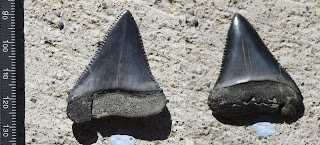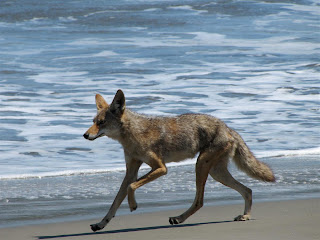I've found that shark teeth are nearly impossible to find during the summer months, and easy to find in the winter, when the cliffs are cleaned off by surf action. I rarely find teeth in the summer simply because I tend to pick the localities clean in the winter, and I have to wait until the erosion of the following winter to find anything. Shark teeth are so rare in west coast strata that it is not very fruitful to look for them on nearby beaches; indeed, I found one Carcharodon tooth in this manner, in 2006 - and I have not found another this way.
Certainly, the Purisima Formation is not the only shark-tooth yielding unit on the west coast. Two rock units that boast a healthy dose of shark teeth are the Sharktooth Hill Bonebed in the Round Mountain Silt near Bakersfield, one of the highest concentrations of fossil shark teeth in the world - and the Santa Margarita Sandstone near Santa Cruz. At both of these localities, one can find dozens of teeth with little work (Sharktooth Hill) or quite a bit of digging (Santa Margarita Sandstone). In high school, I played hooky one day and drove down to Santa Cruz, and spent 8 hours in a pit with a shovel and my screen, and collected 70 teeth - but only after ending up with enough screened sediment to fill a Volkswagen beetle.
 Fossil mako teeth (Cosmopolitodus hastalis and Cosmopolitodus planus) from the Sharktooth Hill Bonebed, UCMP Collections (image borrowed from http://www.ucmp.berkeley.edu/).
Fossil mako teeth (Cosmopolitodus hastalis and Cosmopolitodus planus) from the Sharktooth Hill Bonebed, UCMP Collections (image borrowed from http://www.ucmp.berkeley.edu/). In 2005, I was fortunate to contrast my west coast experience with that of Calvert Cliffs. I had three hours to check out the famous Brownie's Beach, where just looking through shelly debris on the beach, I found 80 shark teeth (mostly the reef shark Carcharinus), just on the surface of the beach, in an area smaller than one side of a tennis court. I've seen mason jars filled with shark teeth folks have scooped up from Florida beaches, and seen multitudes of shark teeth from the famous Lee Creek mine in North Carolina. Sure, there is plenty of lore and mysticism surrounding east coast shark teeth (and their collectors in particular!), but I have gotten the distinct impression that most shark-bearing strata on the west coast are depauperate compared to that on the east coast. Contrast nearly 100 teeth per 3 hours of work to 30 hours of work for one tooth, for example. Additionally, although I have not personally collected data on this, the obscene number of shark teeth from certain east coast units (i.e. 24,000 shark teeth from Calvert Cliffs from just 3 years of donations to the Calvert Marine Museum; Visaggi and Godfrey 2010) suggests that the ratio of sharks:marine mammals in the east coast is astronomically higher than in the Purisima Formation (which in my thesis, I determined it to be around 1:40) and other west coast units. How could this be?
A number of biological and taphonomic hypotheses can be made:
1) The fossil shark assemblages perhaps differ in their taxonomic composition, and perhaps there is some related preservation bias.
2) The western Atlantic had higher productivity and stronger upwelling in the Neogene, supporting a larger absolute population of sharks.
3) Sharks and marine mammals have a different preservation potential, which a large-scale taphonomic process could act upon.
Immediately dismissing out of hand absurd suggestions like fossil marine vertebrates were preserved differently along either coast or had different skeletal mineralogy between ocean basins, one can start to think about the above suggestions. For example, contrasting the Carcharodon carcharias-dominated shark assemblage of the Purisima Formation with that of the Calvert Formation which is dominated by carchariniforms like Carcharinus, Hemipristis, and Galeocerdo, this suggestion seems to have some merit. However, there is little difference in preservation potential between these different types of sharks, aside from differences in size. In general, marine vertebrate assemblages in bonebeds and the like are very poorly sorted, and all shark teeth are relatively small in comparison, to say, a whale jaw.
The second suggestion has some merit: the old skeletal supply v. concentration idea discussed by Susan Kidwell back in her 1985 paper (although she was talking about mollusks). She argued that skeletal concentrations are usually caused by changes in sedimentation rate - a slowdown in the rate of sedimentation eliminates the diluting effect on bioclasts, allowing them to form a shell or bonebed (or even just a zone where they are slightly more abundant). Kidwell also argued that computer modelling she used demonstrated that her concentration model still worked even when the skeletal supply rate changed. Is it reasonable to assume that the populations of organisms have not changed through time? Of course not. Can we, from a uniformitarian standpoint, work with this in mind? Using Kidwell's model, perhaps - perhaps not. This being said, I'm not sure that more teeth = more sharks. This is a relatively simplistic view of the fossil record, and in the past, interpreting the paleoecology of fossil organisms has been fraught with problems (usually of the taphonomic kind). Sharks aren't the only organisms who would enjoy higher productivity - you'd expect marine mammals to be going bat-shit crazy with all the extra fish, krill, etc. to feed on as well (and eventually dying, shedding their hard parts onto the seafloor as well along with shark teeth).
What about the third suggestion? Sharks and marine mammals clearly have different skeletal anatomy, and although some elasmobranchs have been found with preserved skeletal elements (including skates from the Purisima Formation - stay tuned!), all that typically preserve are teeth, and occasionally, dermal denticles. Marine mammals have teeth, skulls, earbones, and postcrania that get preserved frequently. Teeth are harder than bones, and probably have a higher preservation potential with respect to purely physical taphonomic processes (i.e. abrasion from winnowing, erosion, and transport). In fact, my data from my master's thesis indicate that shark teeth are less commonly abraded or fragmented relative to marine mammal bones, and therefore it is probably kosher to say they have a higher preservation potential.
Okay, so what? There is clearly some differential preservation potential. But the Atlantic and Pacific oceans are big places: any specific sedimentological process (i.e. bonebed formation) is going to vary along hundreds of miles of the continental shelf, and through geologic time, and it may be difficult to pinpoint one single phenomenon responsible. In fact, to really examine this, we have to zoom way far out, to the basin level. What is the single most obvious difference between Neogene strata of the east coast and the west coast? Again we turn back to the work of Susan Kidwell (1993). In general, because the east coast is a passive continental margin, most of the strata (i.e. Calvert Fm., Pungo Ls., Yorktown Fm., Bone Valley Fm.) are deposited in low subsidence settings ('low' sensu Kidwell, 1993). Most of the strata on the west coast, including the Purisima Fm., are deposited in smaller basins undergoing "wrench" tectonics (i.e. pull-apart basins) or even rifting (Imperial Group, southern California), which Kidwell (1993) classified as medium-high subsidence basins; most basins in California probably qualify under this category (and could be determined via deposition 'rates' and basin thickness/depth).
The concept of supply versus concentration in Kidwell's model can be extrapolated to an entire basin: basin subsidence controls the sedimentation rate, and instead of looking at the microanatomy of a single shellbed, the types of fossil concentrations and their thicknesses and lateral extent can be compared between formations and basins. Just like a longer pause in sedimentation may form thicker shell bed, a formation deposited under lower rates of sedimentation will result in more numerous, thicker, and more architecturally complex shell concentrations. The Calvert Formation in particular was Kidwell's example of a low-subsidence setting. In general, Neogene marine strata of the west coast in general have less numerous and thinner shell concentrations, a general proxy for the sedimentation rate.
A taphonomic process of this magnitude can then be imparted upon a given example of differential preservation: at the end of this, the generally lower sedimentation rate of the western Atlantic resulted in higher amounts of taphonomic damage, more widespread and longer-duration hiatuses/bonebeds, and could have effectively acted as a taphonomic "wedge". By wedge, I am referring to the eventual difference in the preserved abundances of shark teeth and marine mammal bones. Marine mammal bones, with their relatively lower preservation potential, perhaps lost out due to their greater susceptibility to damage by abrasion and fragmentation.
References Cited
Kidwell, S. M. 1985. Paleobiological and sedimentological implications of fossil
concentrations. Nature 318:457-460.
Kidwell, S. M. 1993. Influence of subsidence on the anatomy of marine siliciclastic
sequences and on the distribution of shell and bone beds. Journal of the Geological
Society, London 150:165-167.
Visaggi, C.C. and S.J. Godfrey. 2010. Variation in Composition and Abundance of Miocene Shark Teeth from Calvert Cliffs, Maryland. Journal of Vertebrate Paleontology 30:1:26-35.




















